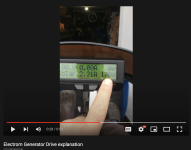I've searched a lot online and here but not found any decent info on this. I've seen people rig regular bicycles to car alternators to make a generator. But it would seem efficient to me for space and money, to use one bike for both transport and energy production (for low energy use off grid life or living on the road.
So, my question is:
Can we use a regular ebike with a hub motor that has regenerative breaking, to charge a battery when stationary?
For example, make a stand for it so it doesn't travel, but turn regenerative breaking on to give resistance so you can peddle and generate electricity?
I've seen one video of someone doing similar but having to make complicated re-wiring. I am guessing his motor didn't have regenerative breaking. So I'm thinking it could be simpler with a motor than has regenerative breaking.
Would this be a relatively efficient way of doing things? Relative that is to the more common DIY bicycle generators?
Other questions that arise are, is regenerative breaking a simple 'on/off/ matter, or does regenerative breaking increase as you squeeze the break more? I ask this since I wonder if simply being 'on' might give too much resistance and be too hard to peddle, and if so, having variable breaking would be handy.
Does anyone have experience or links with this? Or other ideas?
I'm thinking that peddling for an hour should be enough to use LED lighting for a very long time! For example there was the Gravity Light, now replaced by NowLight, for which 15 minutes of pulling on the cord with your hands gives 2 hours of light or 15 minutes of phone call use. Using our legs should give far far more. Though I don't know how a hub motor for generation would compare with their system:
https://deciwatt.global/shop/nl01

Would be great to use an electric bike in this way as it would make the bike, the motor, and the batteries, all doubly useful. Whether for low-impact minimal off grid life or travelling on the road. Also aside from not having to duplicate systems, this should be way quieter than the versions using a regular bike with a pulley to an alternator - those things are noisy!
If anyone knows about this, does anyone know what the best hub motor might be for this that's legal in the UK? (We have a 250W limit here which I guess is flexible but yeah that's the official limit).
So, my question is:
Can we use a regular ebike with a hub motor that has regenerative breaking, to charge a battery when stationary?
For example, make a stand for it so it doesn't travel, but turn regenerative breaking on to give resistance so you can peddle and generate electricity?
I've seen one video of someone doing similar but having to make complicated re-wiring. I am guessing his motor didn't have regenerative breaking. So I'm thinking it could be simpler with a motor than has regenerative breaking.
Would this be a relatively efficient way of doing things? Relative that is to the more common DIY bicycle generators?
Other questions that arise are, is regenerative breaking a simple 'on/off/ matter, or does regenerative breaking increase as you squeeze the break more? I ask this since I wonder if simply being 'on' might give too much resistance and be too hard to peddle, and if so, having variable breaking would be handy.
Does anyone have experience or links with this? Or other ideas?
I'm thinking that peddling for an hour should be enough to use LED lighting for a very long time! For example there was the Gravity Light, now replaced by NowLight, for which 15 minutes of pulling on the cord with your hands gives 2 hours of light or 15 minutes of phone call use. Using our legs should give far far more. Though I don't know how a hub motor for generation would compare with their system:
https://deciwatt.global/shop/nl01

Would be great to use an electric bike in this way as it would make the bike, the motor, and the batteries, all doubly useful. Whether for low-impact minimal off grid life or travelling on the road. Also aside from not having to duplicate systems, this should be way quieter than the versions using a regular bike with a pulley to an alternator - those things are noisy!
If anyone knows about this, does anyone know what the best hub motor might be for this that's legal in the UK? (We have a 250W limit here which I guess is flexible but yeah that's the official limit).




